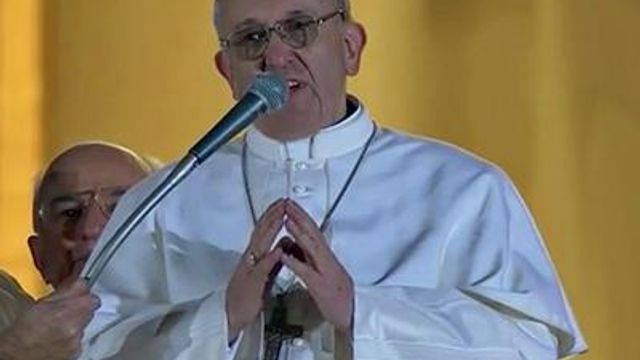Pope Francis elected 266th pontiff of Roman Catholic Church
Argentine Jorge Bergoglio has been elected pope, the first ever from the Americas and the first from outside Europe in more than a millennium. He chose the name Pope Francis.
Posted — UpdatedA stunned-looking Bergoglio shyly waved to the crowd of tens of thousands of people who gathered in St. Peter's Square, marveling that the cardinals had had to look to "the end of the earth" to find a bishop of Rome.
He asked for prayers for himself, and for retired Pope Benedict XVI, whose stunning resignation paved the way for the tumultuous conclave that brought the first Jesuit to the papacy. The cardinal electors overcame deep divisions to select the 266th pontiff in a remarkably fast conclave.
Bergoglio had reportedly finished second in the 2005 conclave that produced Benedict — who last month became the first pope to resign in six centuries.
The 76-year-old archbishop of Buenos Aires has spent nearly his entire career at home in Argentina, overseeing churches and shoe-leather priests.
Tens of thousands of people who braved cold rain to watch the smokestack atop the Sistine Chapel jumped in joy when white smoke poured out a few minutes past 7 p.m. as the bells of St. Peter's Basilica and churches across Rome pealed.
Chants of "Long live the pope!" arose from the throngs of faithful, many with tears in their eyes. Crowds went wild as the Vatican and Italian military bands marched through the square and up the steps of the basilica, followed by Swiss Guards in silver helmets and full regalia.
They played the introduction to the Vatican and Italian anthems and the crowd, which numbered at least 50,000, joined in, waving flags from countries around the world.
"I can't explain how happy I am right down," said Ben Canete, a 32-year-old Filipino, jumping up and down in excitement.
Elected on the fifth ballot, Pope Francis was chosen in one of the fastest conclaves in years, remarkable given there was no clear front-runner going into the vote and that the church had been in turmoil following the upheaval unleashed by Pope Benedict XVI's surprise resignation.
A winner must receive 77 votes, or two-thirds of the 115, to be named pope.
For comparison's sake, Benedict was elected on the fourth ballot in 2005 — but he was the clear front-runner going into the vote. Pope John Paul II was elected on the eighth ballot in 1978 to become the first non-Italian pope in 455 years.
Patrizia Rizzo ran down the main boulevard to the piazza with her two children as soon as she heard the news on the car radio. "I parked the car ... and dashed to the square, she said. "It's so exciting, as Romans we had to come."
The conclave played out against the backdrop of the first papal resignation in 600 years and revelations of mismanagement, petty bickering, infighting and corruption in the Holy See bureaucracy. Those revelations, exposed by the leaks of papal documents last year, had divided the College of Cardinals into camps seeking a radical reform of the Holy See's governance and those defending the status quo.
The names mentioned most often as "papabile" — a cardinal who has the stuff of a pope — included Cardinal Angelo Scola, the archbishop of Milan, an intellect in the vein of Benedict but with a more outgoing personality, and Cardinal Marc Ouellet, the Canadian head of the Vatican's important bishops' office who is also scholarly but reserved like Benedict.
Brazilian Cardinal Odilo Scherer is liked by the Vatican bureaucracy but not by all of his countrymen. And Cardinal Peter Erdo of Hungary has the backing of European cardinals who have twice elected him as head of the European bishops' conference.
On the more pastoral side is Cardinal Sean O'Malley of Boston, the favorite of the Italian press, and Cardinal Timothy Dolan, the back-slapping, outgoing archbishop of New York who has admitted himself that his Italian is pretty bad — a drawback for a job that is conducted almost exclusively in the language.
The Vatican spokesman, the Rev. Federico Lombardi said it was a "good hypothesis" that the pope would be installed next Tuesday, on the feast of St. Joseph, patron saint of the universal church. The installation Mass is attended by heads of state from around the world, requiring at least a few days' notice.
Benedict would not attend, he said.
Thousands of people braved a chilly rain on Wednesday morning to watch the 6-foot- (2-meter-) high copper chimney on the chapel roof for the smoke signals telling them whether the cardinals had settled on a choice. Nuns recited the rosary, while children splashed in puddles.
Unlike the confusion that reigned during the 2005 conclave, the smoke this time around was clear: black during the first two sets of smoke signals, and then clearly white on Wednesday night — thanks to special smoke flares akin to those used in soccer matches or protests that were lit in the chapel ovens to accompany the smoke from the burned ballot papers.
The Vatican on Wednesday divulged the secret recipe used: potassium perchlorate, anthracene, which is a derivative of coal tar, and sulfur for the black smoke; potassium chlorate, lactose and a pine resin for the white smoke.
The chemicals were contained in five units of a cartridge that is placed inside the stove of the Sistine Chapel. When activated, the five blocks ignite one after another for about a minute apiece, creating the steady stream of smoke that accompanies the natural smoke from the burned ballot papers.
Despite the great plumes of smoke that poured out of the chimney, neither the Sistine frescoes nor the cardinals inside the chapel suffered any smoke damage, Lombardi said.
Copyright 2024 by WRAL.com and the Associated Press. All rights reserved. This material may not be published, broadcast, rewritten or redistributed.






